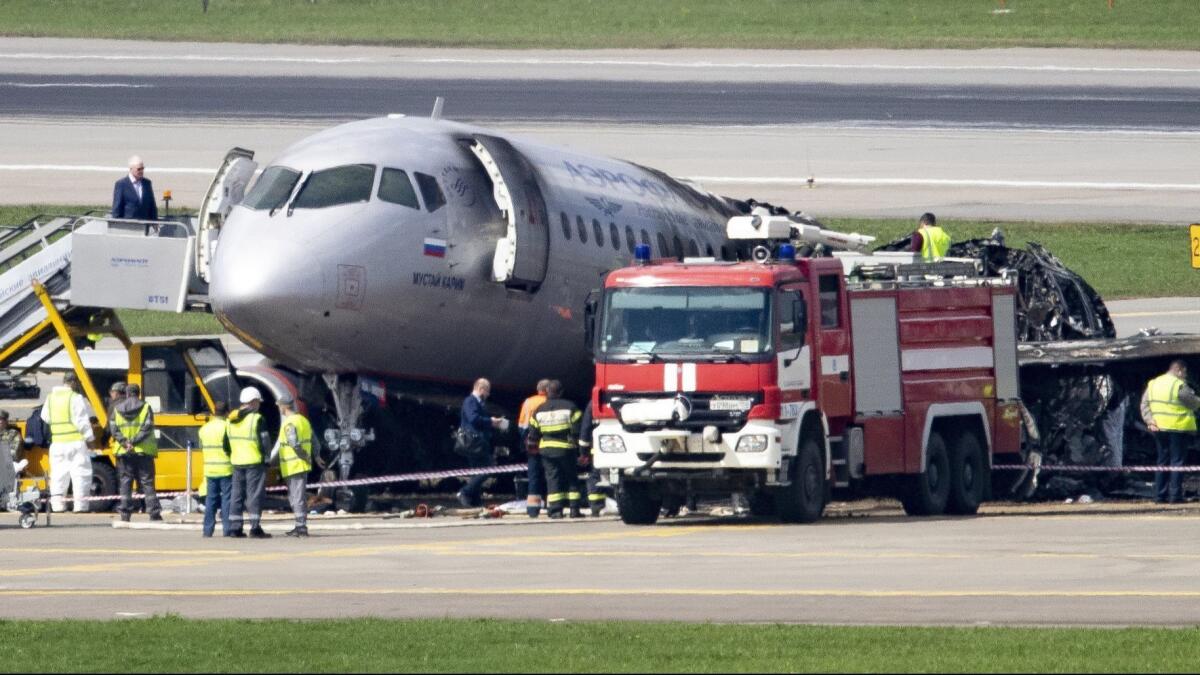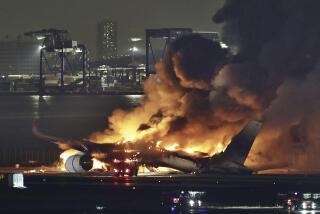If your plane crashes, leave your stuff behind unless you really want to die

- Share via
The recent deadly crash of Aeroflot flight SU1492 raises troubling questions about passenger behavior during the emergency evacuation. To wit: The evacuation was hampered and people may have died because some evacuees stopped to collect their belongings, according to airport officials and witness accounts.
As passengers in the rear of the aircraft were being consumed by flames, video of the incident shows multiple passengers sliding down emergency chutes at the forward exits. Some were carrying their luggage.
On May 5, fighting foul weather, the flight departed Moscow for the Russian city of Murmansk, about 1,200 miles north. The flight circled Moscow twice and returned for an emergency landing about 30 minutes later. Witnesses claim the aircraft, a Russian-made Sukhoi Superjet SSJ-100, was struck by lightning. The official reason for the crash has not yet been released.
As the disabled aircraft bounced along the runway, its fuel tanks erupted. The aft of the plane burst into flames. Chaos erupted inside the cabin as panicked passengers rushed toward the emergency exits at the front.
Of the 78 passengers and crew on board, at least 41 have died.
Once a year, for the past 33 years of my 33-year flight attendant career, I’ve participated in annual Federal Aviation Administration-mandated training. Along with 115,000 U.S.-based flight attendants, I’m tested on my knowledge of and ability to use emergency equipment in case of an airline tragedy.
The most critical part of the two-day training exercise occurs when we step onto aircraft mock-up trainers made of actual aircraft interiors. During this phase, we open real aircraft doors that simulate the inflation of emergency chutes. As this is happening, we’re required to shout evacuation commands at nonexistent passengers. Instructors closely monitor all activity.
The verbal evacuation commands, written by airline safety personnel and sanctioned by the FAA, must be repeated word-for-word and bellowed so that any passenger in the airplane cabin can hear.
Flight attendants who make mistakes — omitting words, reciting words out of sequence, stuttering, pausing too long or speaking softly — fail the exam. They are allowed a redo. Ultimately, if a flight attendant fails to properly execute evacuation commands, he or she will be grounded.
During real-world evacuations like the recent one in Moscow, passengers rely on flight attendants for help and guidance. Dmitry Khlebushkin, one of the passengers, said he owes his life to flight attendants.
But witnesses later said Khlebushkin impeded the evacuation by stopping to gather his backpack.
Other than guiding you toward an exit, flight attendants’ most critical assistance is this command: “Don’t take anything with you!”
This is a direct quote from my in-flight manual — the flight attendant bible of rules, regulations and procedures, which includes a detailed section on emergency evacuation commands. Once an aircraft door is opened and the emergency slide is deployed, the flight attendant manning that door is required to shout, “Come this way …. Don’t take anything with you!”
“Don’t take anything with you” means you do not stop to gather your luggage. You do not pause to grab your backpack. You do not rummage for laptops or purses or that gift you recently purchased for a loved one.
“Don’t take anything with you” means you get out of the aircraft immediately. Follow the voice encouraging you to “Come this way” and head for the exit.
In the seconds it might take to retrieve belongings, your life — and the lives of passengers in the chaotic aisle behind you — may be lost.
Struggling to retrieve luggage while trying to evacuate a burning aircraft is a stupid, callous, potentially injurious and perhaps deadly act of selfishness. And yet some passengers appear to have done just that.
“The first passengers tried to throw out their bags from the cabin and then to slide down,” Britain’s Mirror reported one witness saying. “This is why there are delays [in the evacuation].”
In mock airplane evacuation exercises like the one U.S. flight attendants participate in annually, it is impossible to re-create the fear and panic that ensued during the evacuation of Aeroflot flight SU1492. Flight attendant training occurs in a controlled environment.
No crew member knows exactly how he, she or the passengers we serve will react in a real-world crisis. I trust that 33 years of repetitive training will kick in if I am unlucky.
In the unlikely event you are involved in the evacuation of a commercial aircraft, please heed our most basic request:
“Don’t take anything with you.”
“Don’t take anything with you.”
“Don’t take anything with you.”
The extra three or four seconds it takes to retrieve your precious belongings may be a death sentence for somebody else.
More to Read
Sign up for The Wild
We’ll help you find the best places to hike, bike and run, as well as the perfect silent spots for meditation and yoga.
You may occasionally receive promotional content from the Los Angeles Times.






